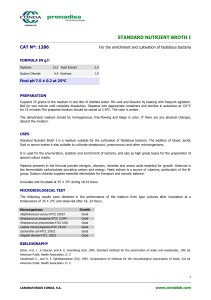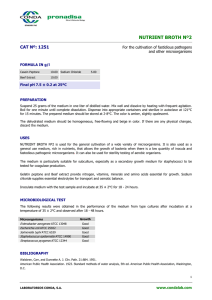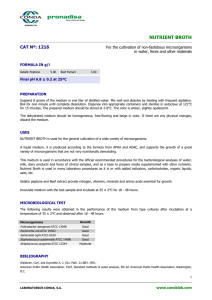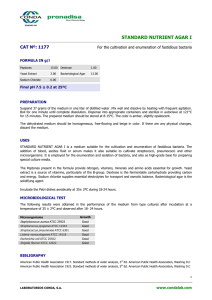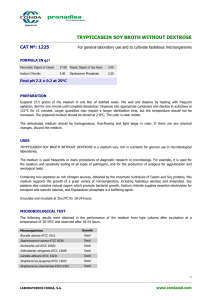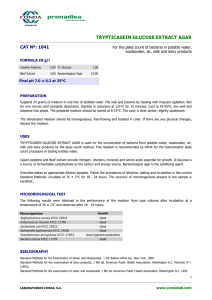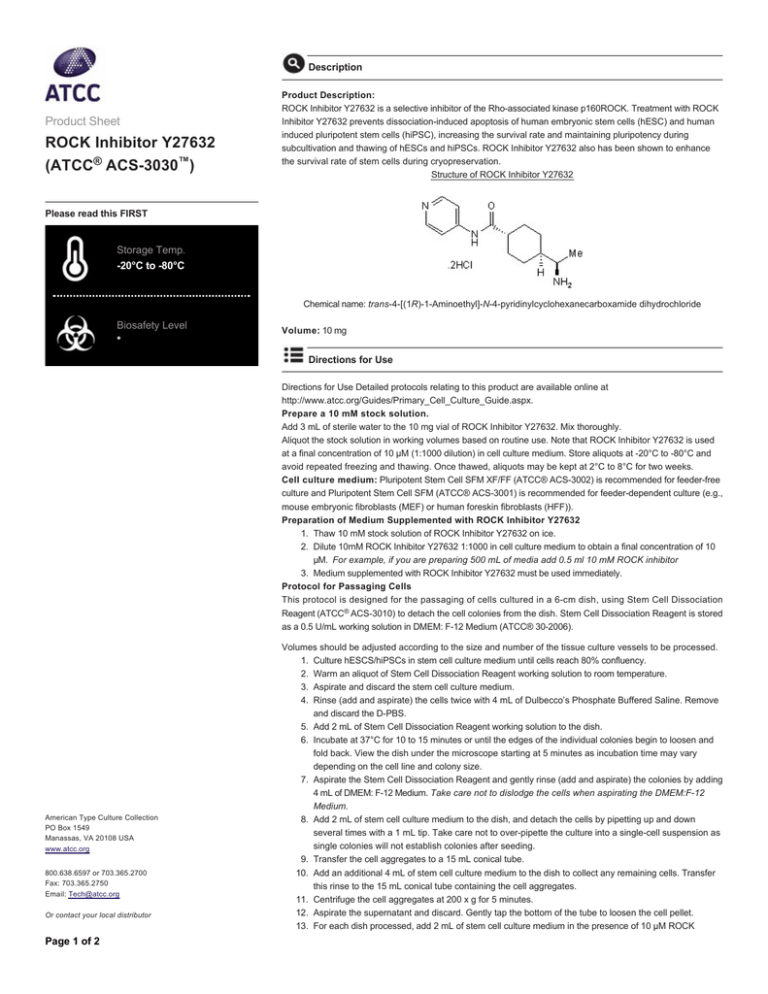
Description
Product Sheet
ROCK Inhibitor Y27632
(ATCC® ACS­3030™)
Product Description:
ROCK Inhibitor Y27632 is a selective inhibitor of the Rho­associated kinase p160ROCK. Treatment with ROCK
Inhibitor Y27632 prevents dissociation­induced apoptosis of human embryonic stem cells (hESC) and human
induced pluripotent stem cells (hiPSC), increasing the survival rate and maintaining pluripotency during
subcultivation and thawing of hESCs and hiPSCs. ROCK Inhibitor Y27632 also has been shown to enhance
the survival rate of stem cells during cryopreservation.
Structure of ROCK Inhibitor Y27632
Please read this FIRST
Storage Temp.
­20°C to ­80°C
Chemical name: trans­4­[(1R)­1­Aminoethyl]­N­4­pyridinylcyclohexanecarboxamide dihydrochloride
Biosafety Level
*
Volume: 10 mg
Directions for Use
Directions for Use Detailed protocols relating to this product are available online at
http://www.atcc.org/Guides/Primary_Cell_Culture_Guide.aspx. Prepare a 10 mM stock solution.
Add 3 mL of sterile water to the 10 mg vial of ROCK Inhibitor Y27632. Mix thoroughly. Aliquot the stock solution in working volumes based on routine use. Note that ROCK Inhibitor Y27632 is used
at a final concentration of 10 µM (1:1000 dilution) in cell culture medium. Store aliquots at ­20°C to ­80°C and
avoid repeated freezing and thawing. Once thawed, aliquots may be kept at 2°C to 8°C for two weeks. Cell culture medium: Pluripotent Stem Cell SFM XF/FF (ATCC® ACS­3002) is recommended for feeder­free
culture and Pluripotent Stem Cell SFM (ATCC® ACS­3001) is recommended for feeder­dependent culture (e.g.,
mouse embryonic fibroblasts (MEF) or human foreskin fibroblasts (HFF)). Preparation of Medium Supplemented with ROCK Inhibitor Y27632
1. Thaw 10 mM stock solution of ROCK Inhibitor Y27632 on ice.
2. Dilute 10mM ROCK Inhibitor Y27632 1:1000 in cell culture medium to obtain a final concentration of 10
µM. For example, if you are preparing 500 mL of media add 0.5 ml 10 mM ROCK inhibitor
3. Medium supplemented with ROCK Inhibitor Y27632 must be used immediately.
Protocol for Passaging Cells
This protocol is designed for the passaging of cells cultured in a 6­cm dish, using Stem Cell Dissociation
Reagent (ATCC® ACS­3010) to detach the cell colonies from the dish. Stem Cell Dissociation Reagent is stored
as a 0.5 U/mL working solution in DMEM: F­12 Medium (ATCC® 30­2006).
American Type Culture Collection
PO Box 1549
Manassas, VA 20108 USA
www.atcc.org
800.638.6597 or 703.365.2700
Fax: 703.365.2750
Email: Tech@atcc.org
Or contact your local distributor
Page 1 of 2
Volumes should be adjusted according to the size and number of the tissue culture vessels to be processed.
1. Culture hESCS/hiPSCs in stem cell culture medium until cells reach 80% confluency.
2. Warm an aliquot of Stem Cell Dissociation Reagent working solution to room temperature.
3. Aspirate and discard the stem cell culture medium.
4. Rinse (add and aspirate) the cells twice with 4 mL of Dulbecco’s Phosphate Buffered Saline. Remove
and discard the D­PBS.
5. Add 2 mL of Stem Cell Dissociation Reagent working solution to the dish.
6. Incubate at 37°C for 10 to 15 minutes or until the edges of the individual colonies begin to loosen and
fold back. View the dish under the microscope starting at 5 minutes as incubation time may vary
depending on the cell line and colony size.
7. Aspirate the Stem Cell Dissociation Reagent and gently rinse (add and aspirate) the colonies by adding
4 mL of DMEM: F­12 Medium. Take care not to dislodge the cells when aspirating the DMEM:F­12
Medium.
8. Add 2 mL of stem cell culture medium to the dish, and detach the cells by pipetting up and down
several times with a 1 mL tip. Take care not to over­pipette the culture into a single­cell suspension as
single colonies will not establish colonies after seeding.
9. Transfer the cell aggregates to a 15 mL conical tube.
10. Add an additional 4 mL of stem cell culture medium to the dish to collect any remaining cells. Transfer
this rinse to the 15 mL conical tube containing the cell aggregates.
11. Centrifuge the cell aggregates at 200 x g for 5 minutes.
12. Aspirate the supernatant and discard. Gently tap the bottom of the tube to loosen the cell pellet.
13. For each dish processed, add 2 mL of stem cell culture medium in the presence of 10 µM ROCK
Product Sheet
ROCK Inhibitor Y27632
(ATCC® ACS­3030™)
Please read this FIRST
Storage Temp.
­20°C to ­80°C
Biosafety Level
*
Inhibitor Y27632 to the 15­mL tube.
14. Gently resuspend the pellet by pipetting up and down 2 to 3 times with a 1 mL tip, maintaining the
small cell aggregates.
15. For feeder­free cultures: Transfer 0.5 mL of the cell aggregates onto each CellMatrix Gel*­coated
dish that contains 4 mL Complete Pluripotent Stem Cell SFM XF/FF in the presence of 10 µM ROCK
Inhibitor Y27632 for a 1:4 split ratio. *CellMatrix™ Basement Membrane Gel (ATCC® ACS­3035)
For feeder­dependent cultures: Transfer 0.5 mL of the cell aggregates onto each MEF or HFF­
coated dish that contains 4 mL Pluripotent Stem Cell SFM XF in the presence of 10 µM ROCK Inhibitor
Y27632 for a 1:4 split ratio.
16. Swiftly move the dishes in a forward to backward, then left to right pattern, once, to gently disperse
the cells evenly across the surface of the dishes. Incubate dishes overnight at 37°C and 5% CO2.
17. Change medium daily until the colonies are big enough to passage (4 to 5 days). ROCK Inhibitor
Y27632 is not necessary in subsequent cell culture medium changes.
Note: The use of ROCK inhibitor may cause a transient spindle­like morphology effect on the cells. However,
the colony morphology will recover after subsequent media change without ROCK inhibitor
References
1. Li X. et al, ROCK inhibitor improves survival of cryopreserved serum/feeder­free single human embryonic
stem cells. Human Reproduction, Vol.24 No.3 pp 580­589, 2009 PubMed 19056770
ATCC Warranty
The viability of ATCC® products is warranted for 30 days from the date of shipment, and is valid only if the
product is stored and cultured according to the information included on this product information sheet. ATCC
lists the media formulation that has been found to be effective for this strain. While other, unspecified media
may also produce satisfactory results, a change in media or the absence of an additive from the ATCC
recommended media may affect recovery, growth and/or function of this strain. If an alternative medium
formulation is used, the ATCC warranty for viability is no longer valid.
Disclaimers
This product is intended for laboratory research purposes only. It is not intended for use in humans.
While ATCC uses reasonable efforts to include accurate and up­to­date information on this product
sheet, ATCC makes no warranties or representations as to its accuracy. Citations from scientific literature
and patents are provided for informational purposes only. ATCC does not warrant that such information has
been confirmed to be accurate.
This product is sent with the condition that you are responsible for its safe storage, handling, and use.
ATCC is not liable for any damages or injuries arising from receipt and/or use of this product. While
reasonable effort is made to insure authenticity and reliability of strains on deposit, ATCC is not liable for
damages arising from the misidentification or misrepresentation of cultures.
Please see the enclosed Material Transfer Agreement (MTA) for further details regarding the use of this
product. The MTA is also available on our Web site at www.atcc.org
Additional information on this culture is available on the ATCC web site at www.atcc.org.
© ATCC 2016. All rights reserved. ATCC is a registered trademark of the American Type Culture Collection. [03/14]
American Type Culture Collection
PO Box 1549
Manassas, VA 20108 USA
www.atcc.org
800.638.6597 or 703.365.2700
Fax: 703.365.2750
Email: Tech@atcc.org
Or contact your local distributor
Page 2 of 2

